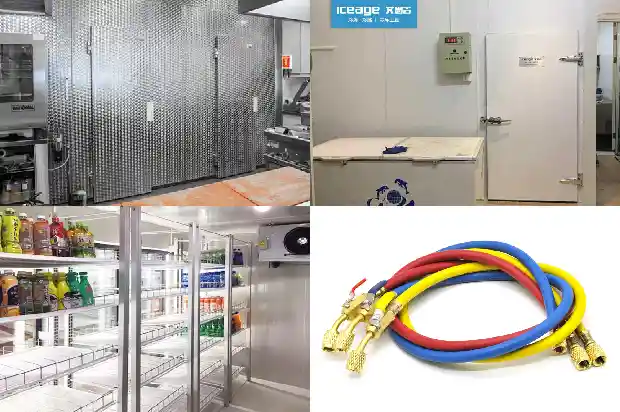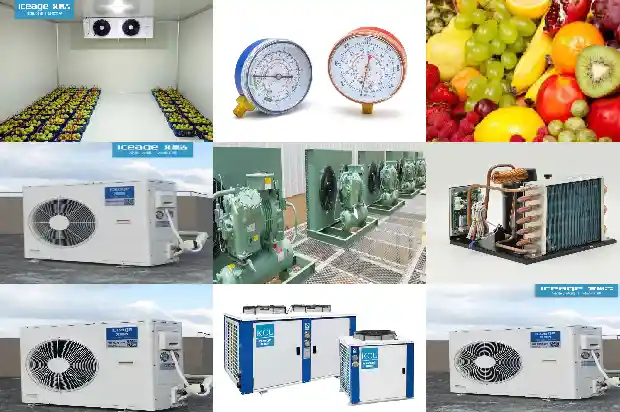How to Read the High - and Low - Pressure Gauges of Refrigeration Air - conditioners?
2025-02-16
Many novices don't know how to read the refrigerant pressure gauge. Especially when they see the densely packed numbers on the dial, many people just skip it and don't want to look. However, the pressure gauge is of great importance in the refrigeration system, covering almost the processes of refrigeration system debugging, maintenance, and repair. It can be said to be an essential part of the refrigeration system.
Today, we will introduce this pressure gauge to you. Hope it will be useful for novices.
First, look at the pictures. First is the high - pressure gauge, and then the low - pressure gauge.
I. Classification of Refrigeration Pressure Gauges
Generally, they are divided into "high - pressure gauges" and "low - pressure gauges".
- The maximum reading of the "low - pressure gauge" is generally 1.5MPa - 1.8MPa.
- The maximum reading of the "high - pressure gauge" is generally 3.5MPa - 3.8MPa.
II. Reading Pressure Values
- For the low - pressure gauge, the values on the outermost circle are in MPa. For example, if the pointer points to 0.
3, the current pressure is 0.3MPa.
- For the high - pressure gauge, the values in the outermost black large characters are in MPa. For example, if the pointer points to 2, the current pressure is 2.0MPa.
- Conversion of different pressure units: 1MPa = 10.2kg/cm² = 10bar = 145Psi
III. Reading Temperature Values
- Low - pressure gauge:
- Counting from the outside in, the 1st circle (black) shows pressure values, with the unit of MPa (megapascal).
- The 2nd circle (green) shows the temperature values of R407C, with the unit of °C (Celsius).
- The 3rd circle (red) shows the temperature values of R134a, with the unit of °C (Celsius).

- The 4th circle (green) shows the temperature values of R22, with the unit of °C (Celsius).
- The 5th circle (green) shows the temperature values of R404A, with the unit of °C (Celsius).
- For example, if a chiller uses R22 as the refrigerant and the low - pressure during operation is 0.4MPa, the corresponding evaporation temperature is approximately 0°C.
- If a chiller uses R134a as the refrigerant and the low - pressure during operation is 0.3MPa, the corresponding condensation temperature is approximately 8°C.
- High - pressure gauge:
- Counting from the outside in, the 1st circle (black) shows pressure values, with the unit of MPa (megapascal).
- The 2nd circle (green) shows the temperature values of R407C, with the unit of °C (Celsius).
- The 3rd circle (red) shows the temperature values of R134a, with the unit of °C (Celsius).
- The 4th circle (green) shows the temperature values of R22, with the unit of °C (Celsius).
- The 5th circle (green) shows the temperature values of R404A, with the unit of °C (Celsius).
- For example, if a chiller uses R22 as the refrigerant and the high - pressure during operation is 1.8MPa, the corresponding condensation temperature is approximately 50°C.
- If a chiller uses R404A as the refrigerant and the high - pressure during operation is 1.8MPa, the corresponding condensation temperature is approximately 45°C.
Supplementary Instructions:
- MPa stands for megapascal; kg/cm² stands for kilogram - force per square centimeter.
- The pressure units of different pressure gauges may vary. Check the markings on the front dial before reading the pressure.
- Chillers and air - conditioners generally use R22, R407C, R134a; low - temperature machines use R22, R404A; household air - conditioners use R22 or R410A; automotive air - conditioners use R134 or R12.
- When the compressor is not running, the pressure is the equilibrium pressure, that is, the high and low pressures are the same, and the pressure value corresponds to the ambient temperature or the water temperature in the water tank.
- For example, when the ambient temperature is 30°C for R22, the equilibrium pressure on the pressure gauge is approximately 1.1MPa.
- For example, when the ambient temperature is 10°C for R22, the equilibrium pressure on the pressure gauge is approximately 0.6MPa.
Related Articles
- Winter Approaches: How to Solve the Low High - pressure Issue of Air - cooled Condensing Units?
- Common Pressure Valves and Protection Devices in Refrigeration Units
- How to Troubleshoot and Repair High - pressure Protection of Air - cooled Units?
- Air - conditioner Low - pressure Alarm? These Nine Common Causes
- Why Does the Evaporation Temperature of the Refrigeration System Drop Too Low? And Why is the Condensing Pressure Too High?
- What are the Cooling and Heating Pressures of an Air Conditioner? How to Calculate the Optimal Refrigerant Quantity?
- Common Causes and Analysis of High and Low Pressure Alarms
- Obscure Knowledge of Static Pressure, Dynamic Pressure, Latent Heat and Sensible Heat in the HVAC Industry
- Multi-split air conditioner: Nitrogen charging for welding, pressure maintaining, vacuuming and refrigerant charging
- What Causes Noise in Pressure Reducing Valves?
- Pressure Gauge in Refrigeration Equipment
- Reasons and Solutions for High and Low Condensing Pressure in Air-cooled and Water-cooled Systems
- Principle of Multiple Storages in One Unit and Evaporation Pressure Regulation Methods
- Causes and Solutions for Elevated Pressure in Cold Storage
- Analysis and Treatment of Common Low-Pressure Faults in Chillers
- What are the effects of pressure and temperature on the refrigeration system of a cold storage?
- Analysis and Treatment of Common Low Pressure Faults in Chillers
- 7 Reasons for Low Air Pressure in Cold Water Unit
